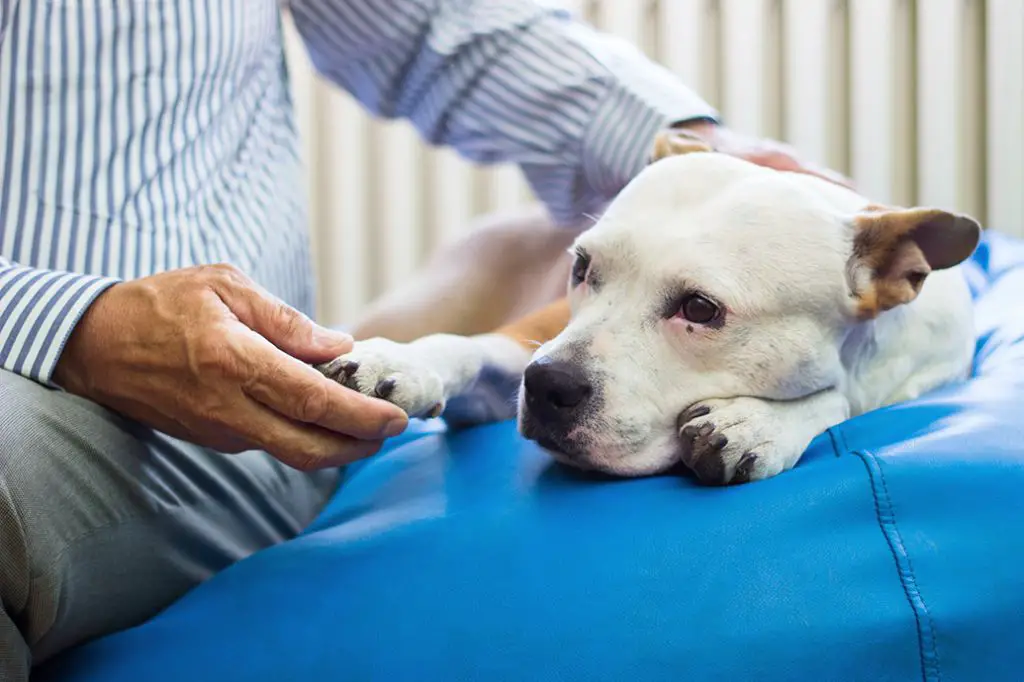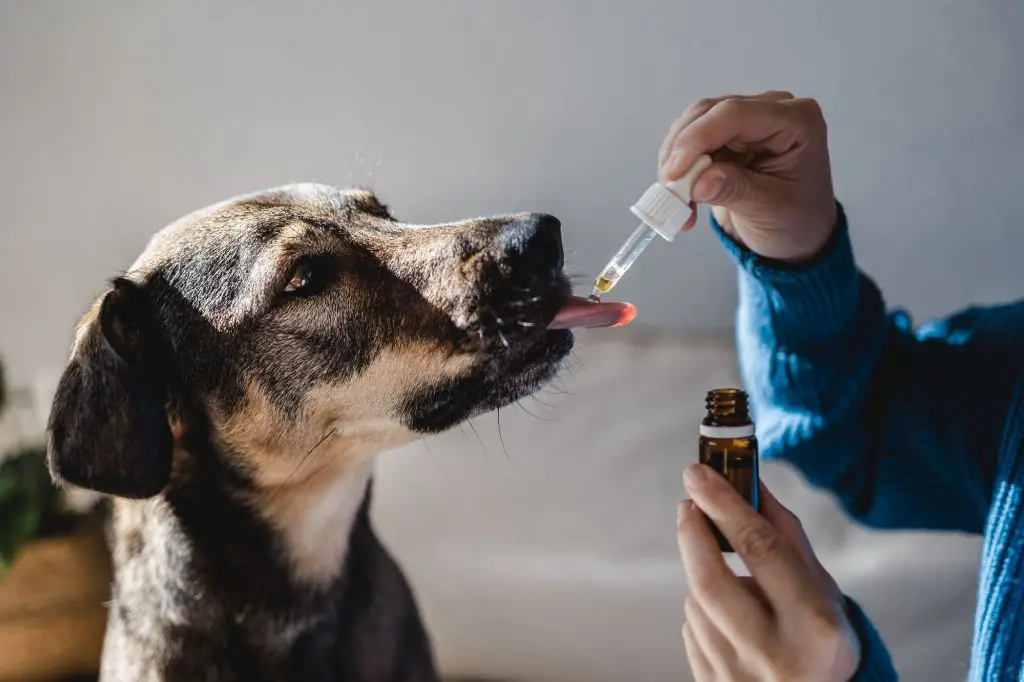Introduction
Many pet owners wonder if female dogs experience stomach cramps or other forms of abdominal discomfort when going through their heat cycles. This is an important question, as being aware of potential signs of pain or distress in our pets allows us to provide better care for them.
In this article, we will take a closer look at the canine heat cycle, common causes of abdominal discomfort in intact female dogs, warning signs to watch out for, and steps you can take to ease any pain your dog may experience during her cycle.
The Heat Cycle in Female Dogs
Female dogs go through heat cycles rather than menstrual cycles like humans. A dog’s heat cycle generally occurs about twice a year, although this can vary by breed and age. The heat cycle has four distinct stages:
Proestrus – This stage lasts approximately 7-10 days. During proestrus, estrogen levels rise and the dog’s vulva swells. The dog will attract male dogs but will not allow breeding. There is sometimes light bleeding during this stage.
Estrus – This is the fertile period of the heat cycle, lasting about 5-10 days. During estrus, estrogen levels drop slightly and progesterone levels increase. The swelling of the vulva will go down and the dog will allow mating. There is often vaginal discharge during this stage.
Diestrus – Diestrus lasts 60-90 days. During this stage, progesterone levels remain high and the dog’s reproductive tract prepares for pregnancy, whether she is pregnant or not. The vulva returns to a normal size.
Anestrus – This is a resting stage that signals the end of the heat cycle. It lasts 2-3 months. During anestrus, the reproductive system shuts down before the next cycle begins. There are no outward signs of heat during this stage.
Signs of Abdominal Discomfort
Female dogs going through their heat cycle can experience abdominal discomfort that may present itself through several behavioral signs. These include:
- Restlessness
- Pacing
- Whining
- Loss of appetite
- Licking or biting at the genital area
- Seeking isolation
- Aggression when approached

The abdominal discomfort is often described as mild cramping similar to menstrual cramps in humans. The pain stems from the swelling of the dog’s vulva and the bleeding during estrus. Some dogs exhibit these signs more severely than others.
In addition to these behavioral changes, a dog experiencing cramps may adopt a hunched posture while standing or lying down. She may tuck her tail and abdomen. Other physical signs can include vomiting, diarrhea, and lethargy.
Being aware of these signs can help identify when a dog requires care to ease her discomfort. Monitoring symptoms is also useful for determining when the dog is most fertile for breeding purposes.
Common Causes
There are several potential causes for abdominal discomfort in female dogs going through their heat cycle. The most common causes include:
-
Uterine Contractions – The uterus contracts during estrus to help flush out its lining. These contractions can be painful and cause cramping.
-
Ovulation – Ovulating and releasing eggs can also cause mild abdominal cramping in some dogs.
-
False Pregnancy – After heat, some female dogs experience false pregnancies with hormonal changes that can cause mammary enlargement, milk production, nesting behaviors and abdominal discomfort.
-
Pyometra – A bacterial infection of the uterus that often causes abdominal swelling, pain, lethargy, vomiting and other symptoms requiring emergency veterinary treatment.
-
Cysts or Tumors – Abnormal fluid-filled sacs or tissue growths on the reproductive organs that may cause intermittent pain.
Determining the exact cause of discomfort requires a veterinary exam. But being aware of the most likely culprits can help owners understand what their dog may be going through during her heat cycle.
When to See the Vet

Female dogs can experience abdominal discomfort and pain for various reasons during their heat cycles. In many cases, symptoms may be mild and can be managed at home. However, there are certain circumstances when you should take your dog to the vet right away for evaluation and treatment.
Contact your vet promptly if your female dog shows any of the following signs:
- Repeated vomiting or diarrhea that lasts more than 24 hours
- Loss of appetite for more than 1-2 days
- Lethargy, weakness, or collapse
- Crying or whining from pain
- Distended or swollen abdomen
- Unproductive straining to urinate or defecate
- Discharge containing blood from vulva
- Fever higher than 103°F
- Shaking, tremors, or seizures
These symptoms can indicate potentially serious conditions like pyometra (uterine infection), pregnancy complications, or gastrointestinal obstructions requiring emergency care. It’s better to err on the side of caution and have your vet examine your dog.
Seeking timely veterinary care can help diagnose and treat any underlying issues, provide pain relief, prevent the situation from worsening, and avoid the need for more invasive interventions later on. Don’t hesitate to contact your vet if your female dog shows concerning signs of abdominal discomfort or distress.
Preventative Care
Dog owners can take several steps to help minimize the abdominal discomfort their female dogs may experience during heat cycles. The most important prevention measure is having the dog spayed, as this eliminates heat cycles entirely. However, for intact dogs, owners can still provide relief and care.
Giving over-the-counter pain medications like baby aspirin or PMS medication can help alleviate cramping. The dosage should be carefully calculated based on the dog’s weight and only given under veterinary guidance. Provide a soft bed or doggie pillow so the dog has cushioning and comfort if she needs to rest.

Gently massage the abdomen and apply warmth with hot water bottles or heating pads on low settings. This can soothe muscle tension. Make sure the dog has easy access to plenty of fresh water to stay hydrated.
Monitor the dog closely for signs of distress, such as whining, panting, trembling, or loss of appetite. Check with a vet if any concerning symptoms appear. With the proper care, most dogs only experience mild to moderate discomfort during heat.
Home Remedies
There are a few home remedies that may provide some relief for a female dog experiencing minor abdominal discomfort related to her heat cycle:
Warm compresses – Place a warm (not hot) compress or heating pad on your dog’s abdomen. The warmth can help relax muscles and improve blood flow. Make sure your dog doesn’t chew or ingest the heating pad.
Massage – Gently massage your dog’s belly. This can help relieve muscle tension, gas, and cramping. Focus on soft, circular motions. Avoid massaging too firmly.
Nutritional supplements – Some supplements like chamomile, ginger, peppermint may help relax the GI tract. Consult your vet before giving any supplements.
Low-fat bland diet – Feed a bland diet of boiled chicken and rice for a couple days to give your dog’s digestive system a rest.
Adequate hydration – Make sure your dog is drinking enough water, which can help move things through the GI tract.
While home remedies may provide minor relief, contact your vet if signs of discomfort persist or seem severe. They can recommend more advanced treatments if needed.
Veterinary Treatments
If home remedies don’t provide relief for your female dog’s abdominal discomfort, a veterinarian can recommend medical treatments tailored to the underlying cause. Some common options include:
– Pain Medication – Vets may prescribe dog-safe NSAIDs (non-steroidal anti-inflammatory drugs) like carprofen or meloxicam to reduce inflammation and provide pain relief.
– Antibiotics – Bacterial infections are a common cause of stomach issues in dogs. Antibiotics can clear up infections and reduce abdominal pain and discomfort.
– IV Fluids – Dehydration from vomiting, diarrhea or lack of appetite can worsen abdominal discomfort. IV fluids can help restore hydration and electrolyte balance.
– Anti-nausea Medication – Drugs like ondansetron can help control nausea and vomiting in dogs.
– Dietary Modifications – Vets may recommend a bland diet, probiotics or prescription GI food to improve digestive health.
– Imaging Tests – X-rays, ultrasounds or endoscopies can diagnose underlying issues like tumors, ulcers or blockages requiring specific treatment.
– Surgery – For severe or recurring abdominal issues, surgery may be needed to remove tumors, foreign objects, correct intestinal issues, etc.
Always consult your veterinarian to determine the best course of treatment for your dog’s individual condition and symptoms.
When to Spay
Spaying your female dog is one way to potentially prevent recurring abdominal discomfort from heat cycles. Spaying refers to the surgical removal of the ovaries and uterus, which eliminates the possibility of pregnancy and stops the production of hormones that drive the heat cycle.
Most vets recommend spaying healthy female dogs around 6 months of age, before they go into their first heat cycle. There are some benefits to waiting until after the first heat cycle, such as allowing the dog to fully physically mature. But spaying before the second heat cycle will prevent unwanted pregnancies and eliminate future heat cycles.
Discuss the pros and cons of spaying with your vet. Spaying requires anesthesia and surgery, so your vet will want to ensure your dog is healthy enough first. Make sure you understand the risks involved. But for most female dogs, spaying is a relatively safe procedure that can prevent recurring abdominal discomfort from heat cycles.
Conclusion
To summarize, female dogs do sometimes experience stomach cramps and abdominal discomfort related to their heat cycles. The discomfort is often caused by contractions in the uterus or gastrointestinal issues stemming from hormonal fluctuations. Signs of discomfort include restlessness, whimpering, lack of appetite, and enlarged mammary glands. While minor discomfort usually resolves on its own, more severe or prolonged symptoms may require veterinary attention. Spaying your dog is the most effective way to prevent recurring menstrual cramps. Overall, some abdominal discomfort during estrus is common but rarely dangerous in healthy female dogs.

In conclusion, the main question asked was “Do female dogs have stomach cramps?” Based on the information provided in this article, the answer is yes, female dogs can and do commonly experience minor abdominal and uterine cramping related to their heat cycles. However, severe or persisting discomfort merits veterinary examination to rule out underlying illness.